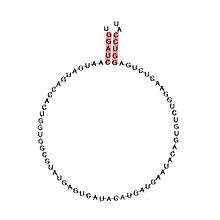Small nucleolar RNA SNORD113
| Small nucleolar RNA SNORD113/SNORD114 family | |
|---|---|
 Predicted secondary structure and sequence conservation of SNORD113 | |
| Identifiers | |
| Symbol | SNORD113 |
| Alt. Symbols | sno_14q_I_II; sno_14q_I |
| Rfam | RF00181 |
| Other data | |
| RNA type | Gene; snRNA; snoRNA; CD-box |
| Domain(s) | Eukaryota |
| GO | 0006396 0005730 |
| SO | 0000593 |
Small nucleolar RNA SNORD113 (also known as C/D box snoRNA 14q(I)) is a small nucleolar RNA molecule which is located in the imprinted human 14q32 locus and may play a role in the evolution and/or mechanism of the epigenetic imprinting process.[1]
In humans the imprinted domain at 14q32 contains two clusters of tandemly repeated small nucleolar RNAs named 14q(I) and 14q(II) snoRNAs. These two clusters contain 9 and 31 highly related snoRNAs respectively. These two related snoRNAs are known as SNORD113 and SNORD114 respectively in the HGNC approved gene symbol nomenclature. The snoRNAs found in each cluster are clearly related and are simply referred to with a 1-9 or 1-31 suffix. All the snoRNAs in these clusters are intron encoded and are processed from the tissue-specific non-coding human MEG8 RNA, which lies downstream of the imprinted genes DLK1 and GTL2.
SNORD113 and SNORD114 belong to the C/D box class of snoRNAs which contain the conserved sequence motifs known as the C box (UGAUGA) and the D box (CUGA). Most of the members of the box C/D family function in directing site-specific 2'-O-methylation of substrate RNAs.[2] However, SNORD113 and SNORD114 differ from most C/D box snoRNAs in their expression profiles (which is tissue specific) and the lack of complementarity to rRNA and SnRNA. As a result, they are not predicted to guide to 2'O-methylation of a rRNA or snRNA.
Homologues of SNORD113 and SNORD114 are found in the imprinted non-coding mouse transcript Rian where they are again found in tandem array of 9 highly related snoRNAs. These snoRNAs also display tissue specific (brain) expression. C/D box snoRNAs were also identified in the rat non-coding Bsr (brain-specific repetitive) RNA.
Another imprinted human locus 15q11q13 encodes tandemly repeated C/D box snoRNA genes which are expressed only from the paternal chromosome. Studies of human and mouse model systems have shown that deletion of the 29 copies of the C/D box snoRNA SNORD116 (HBII-85) from this locus has been shown to be the primary cause of Prader-Willi syndrome.[3][4][5][6][7] A possible role for tandemly repeated C/D snoRNA genes in the evolution and/or mechanism of the epigenetic imprinting process has been suggested.[1]
References
- 1 2 Cavaillé J, Seitz H, Paulsen M, Ferguson-Smith AC, Bachellerie JP (2002). "Identification of tandemly-repeated C/D snoRNA genes at the imprinted human 14q32 domain reminiscent of those at the Prader-Willi/Angelman syndrome region". Hum. Mol. Genet. 11 (13): 1527–38. PMID 12045206. doi:10.1093/hmg/11.13.1527.
- ↑ Galardi, S.; Fatica, A.; Bachi, A.; Scaloni, A.; Presutti, C.; Bozzoni, I. (October 2002). "Purified Box C/D snoRNPs Are Able to Reproduce Site-Specific 2'-O-Methylation of Target RNA in Vitro". Molecular and Cellular Biology. 22 (19): 6663–6668. PMC 134041
 . PMID 12215523. doi:10.1128/MCB.22.19.6663-6668.2002.
. PMID 12215523. doi:10.1128/MCB.22.19.6663-6668.2002. - ↑ Skryabin BV, Gubar LV, Seeger B, et al. (2007). "Deletion of the MBII-85 snoRNA gene cluster in mice results in postnatal growth retardation". PLoS Genet. 3 (12): e235. PMC 2323313
 . PMID 18166085. doi:10.1371/journal.pgen.0030235.
. PMID 18166085. doi:10.1371/journal.pgen.0030235. - ↑ Sahoo T, del Gaudio D, German JR, Shinawi M, Peters SU, Person RE, Garnica A, Cheung SW, Beaudet AL (2008). "Prader-Willi phenotype caused by paternal deficiency for the HBII-85 C/D box small nucleolar RNA cluster.". Nat Genet. 40 (6): 719–21. PMC 2705197
 . PMID 18500341. doi:10.1038/ng.158.
. PMID 18500341. doi:10.1038/ng.158. - ↑ Ding F, Li HH, Zhang S, Solomon NM, Camper SA, Cohen P, Francke U (2008). Akbarian, Schahram, ed. "SnoRNA Snord116 (Pwcr1/MBII-85) deletion causes growth deficiency and hyperphagia in mice.". PLoS ONE. 3 (3): e1709. PMC 2248623
 . PMID 18320030. doi:10.1371/journal.pone.0001709.
. PMID 18320030. doi:10.1371/journal.pone.0001709. - ↑ Ding F, Prints Y, Dhar MS, Johnson DK, Garnacho-Montero C, Nicholls RD, Francke U (2005). "Lack of Pwcr1/MBII-85 snoRNA is critical for neonatal lethality in Prader-Willi syndrome mouse models.". Mamm Genome. 16 (6): 424–31. PMID 16075369. doi:10.1007/s00335-005-2460-2.
- ↑ de Smith AJ, Purmann C, Walters RG, et al. (June 2009). "A Deletion of the HBII-85 Class of Small Nucleolar RNAs (snoRNAs) is Associated with Hyperphagia, Obesity and Hypogonadism". Hum. Mol. Genet. 18 (17): 3257–65. PMC 2722987
 . PMID 19498035. doi:10.1093/hmg/ddp263.
. PMID 19498035. doi:10.1093/hmg/ddp263.
External links
- Page for C/D box small nucleolar RNA SNORD113/SNORD114 family at Rfam
- Entry for SNORD113 at snoRNABase
- Entry for SNORD114 at snoRNABase